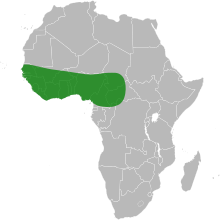African rice
| Oryza glaberrima | |
|---|---|
 |
|
| Seeds of Oryza glaberrima | |
| Scientific classification | |
| Kingdom: | Plantae |
| (unranked): | Angiosperms |
| (unranked): | Monocots |
| (unranked): | Commelinids |
| Order: | Poales |
| Family: | Poaceae |
| Genus: | Oryza |
| Species: | O. glaberrima |
| Binomial name | |
|
Oryza glaberrima Steud. |
|
 |
|
| The range of wild Oryza glaberrima. The plant is cultivated outside its wild range. | |
Oryza glaberrima, commonly known as African rice, is one of the two domesticated rice species. It was first domesticated and grown in West Africa, and was brought to the Americas by enslaved West African rice farmers. It is now largely a subsistence crop, rarely sold in markets even in West Africa.
While it has been partly replaced by higher-yielding Asian rice, and the number of varieties grown is declining, it persists, making up an estimated 20% of rice grown in West Africa. By comparison to Asian rice, it is hardy, pest-resistant, low-labour, suited to a variety of African conditions, filling, and has a distinct nutty flavour. It is also grown for cultural reasons; for instance, it is sacred to awasena followers among the Jola people, and is a heritage variety in the United States.
Crossbreeding between African and Asian rice is difficult, but there exist some crosses.
Humans have independently domesticated two different rice species. African rice was domesticated from wild African rice, Oryza barthii, while Asian rice (Oryza sativa), was domesticated from wild Asian rice, Oryza rufipogon.
Oryza barthii still grows wild in Africa, in a wide variety of open habitats. The Sahara was formerly wetter, with massive paleolakes in what is now the Western Sahara. As the climate dried, the wild rice retreated and probably became increasingly domesticated as it relied on humans for irrigation. Rice growing in deeper, more permanent water became floating rice
It is believed to have been domesticated 2000–3000 years ago in the inland delta of the Upper Niger River, in what is now Mali. It then spread through West Africa. It has also been recorded off the east coast of Africa, in the Zanzibar Archipelago.
...
Wikipedia
